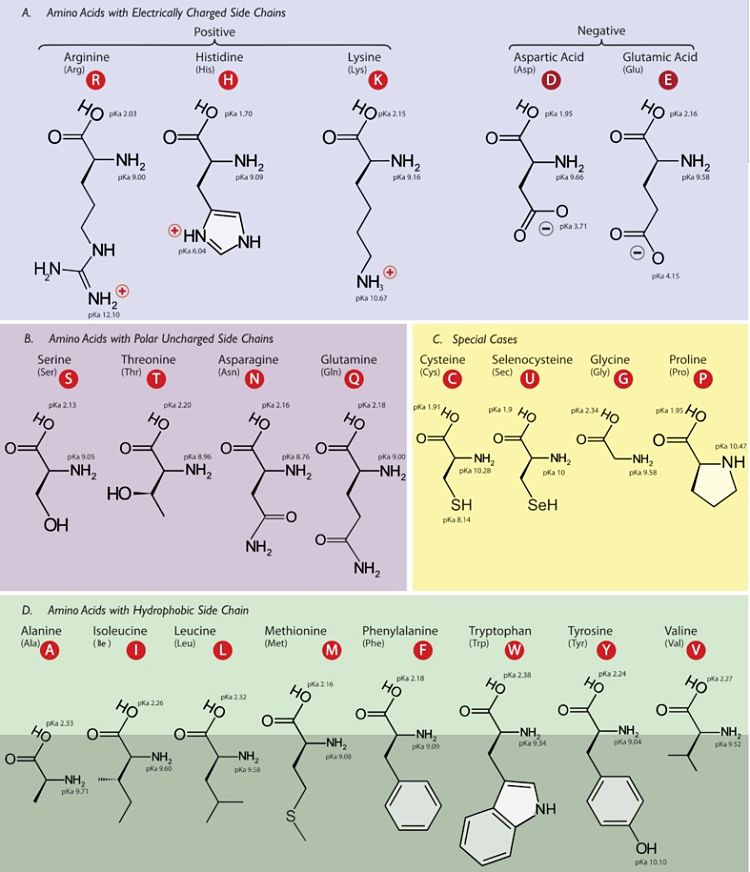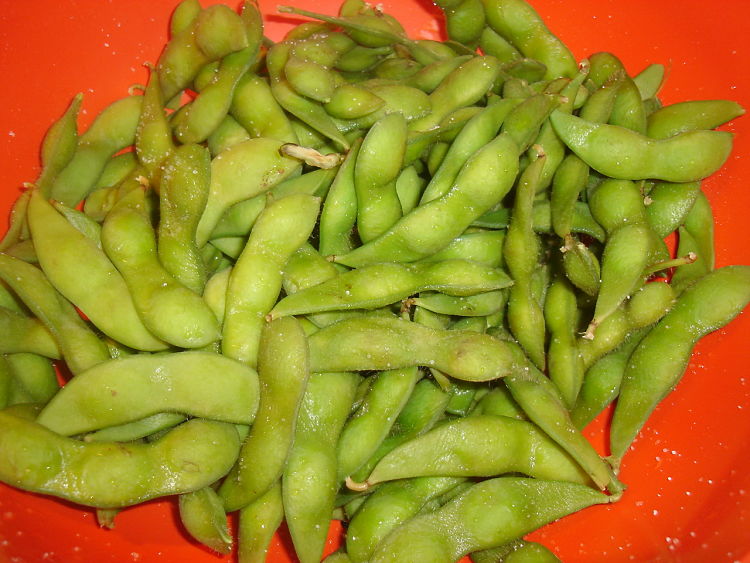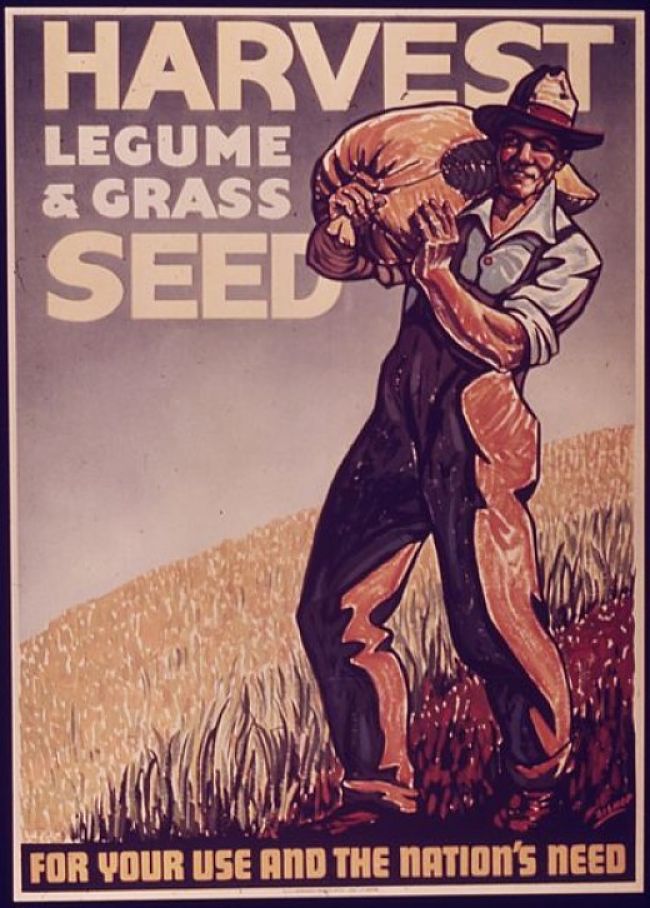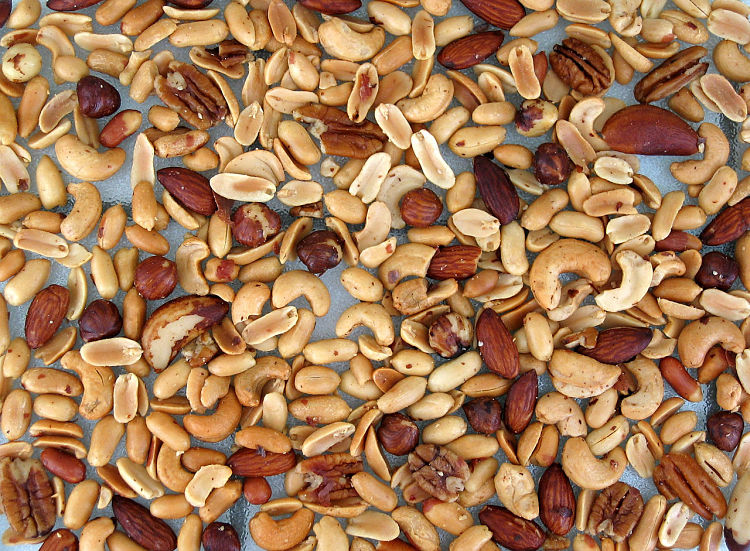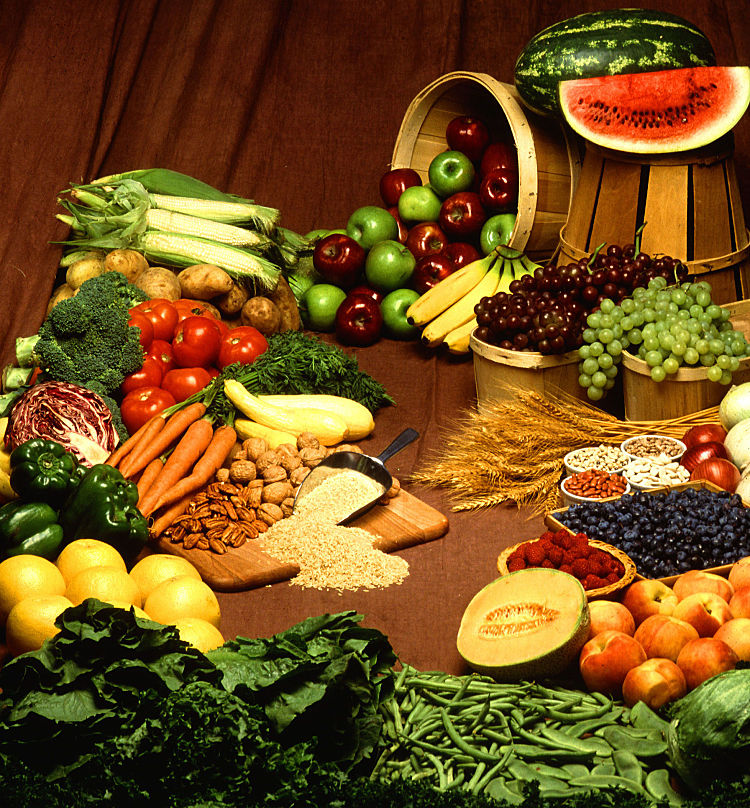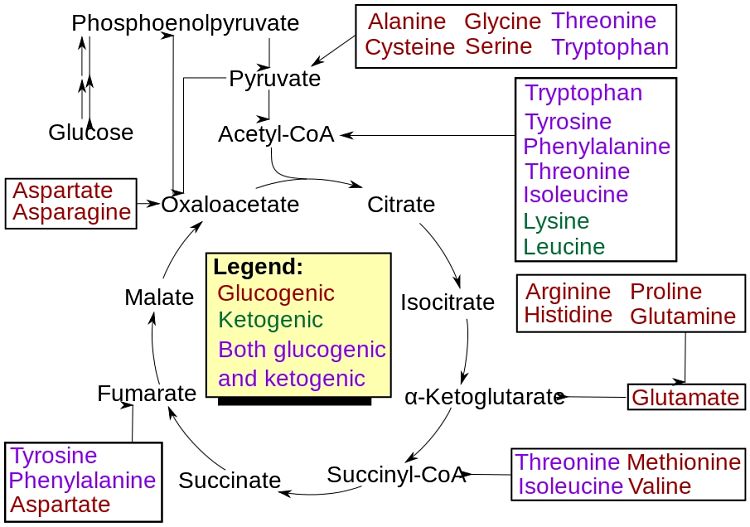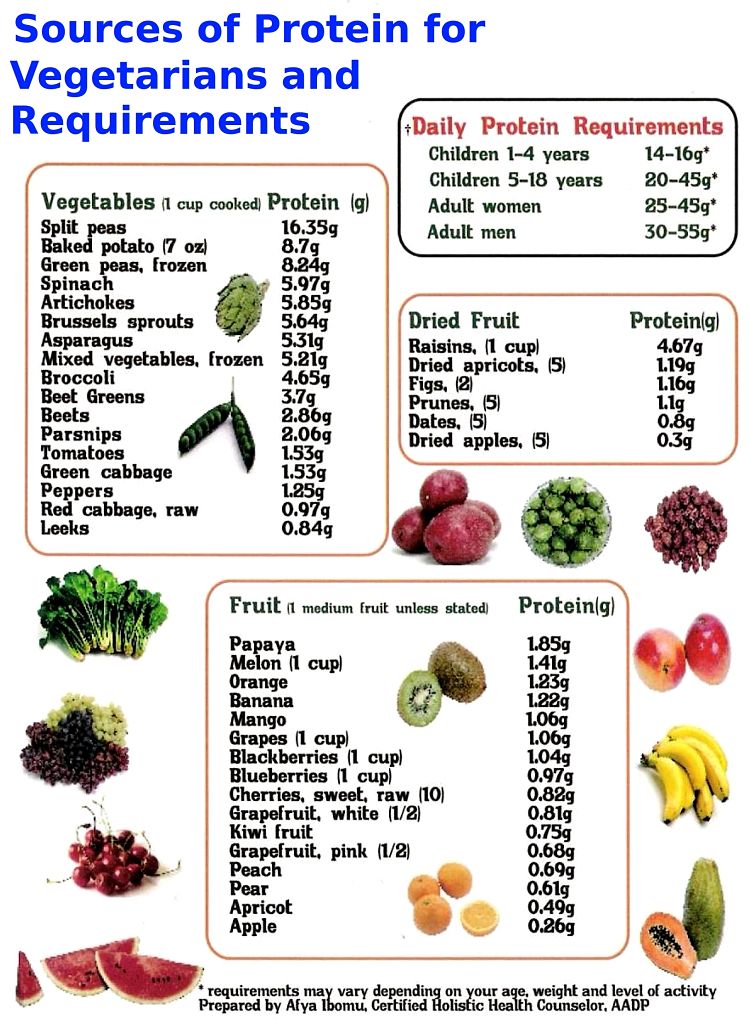Going Vegan - Nutrient, Food, Physical, Social and Economic Challenges
It has been estimated that about 3% of American adults, roughly about 7.5 million people, eat a vegetarian diet, and about 30% of them (1 million people) are strict vegans, who aim to eat no animal products at all.
This means eating no meat, milk, fish, eggs, cheese or even honey and vitamins derived from animal extracts.
It can be an extreme challenge as many vegans are unaware that the pill capsules used for many medicines are derived from gelatine - a product produced from animal bones and hooves.
The number of people have tried vegetarian or vegan diets and failed is anyone's guess.
Many people may also adopted the myriad of variants that allow various food items to be included and these numbers are also unknown. Being an absolutely strict vegan means no animal products whatsoever.
This can be a hard campaign on several fronts. This article discusses the range of challenges facing someone going vegan and how to beat them.
- Knowledge
- Nutrients - getting enough protein and avoiding vitamin and nutrient deficiencies
- Physical Challenges
- Heath Issues
- Social Issues - Eating Out
- Economic Challenges
As countless aspiring vegans are finding out the hard way, the switch from meat-eater to strict herbivore is a path strewn with many challenges. Favorite foods like butter, cheese and milk products can be made more difficult by family and friends who complain that you won't eat the lovely food they have prepared because of a teaspoon of butter used to fry the mushrooms. Alternatives such as rice and almond milk take a lot of getting used to. Vegan special foods can be very hard to find and may cost two to three times what the standard foods cost. People who have just started on vegan diets may struggle as everything on the shelves, even in the vegetarian section has hidden traces of animal products.
For many long-term vegetarians who want to make the switching to a strict vegan diet the toughest past is giving up cheese and yogurt. Vegan cheese alternative are not very appealing and are hard to find.
Major Health Issues for Vegans
Medical research studies have shown that vegetarian diets include relatively large amounts of nuts, fruits cereals, pulses and vegetables.
In terms of vitamins and nutrients, vegetarian and vegan diets are usually rich in:
- carbohydrates
- n-6 fatty acids
- folic acid
- vitamin C
- dietary fibre
- carotenoids
- vitamin E
- Magnesium
But vegetarian diets are relatively poor in:
- protein
- saturated fat
- retinol
- long-chain n-3 fatty acids
- Zinc
- calcium (particularly for Vegans because dairy products excluded)
- vitamin B(12) (particularly for Vegans)
Comparative studies of vegans and vegetarians have shown that they have a relatively low BMI (low weights) and a low plasma cholesterol concentration. Vegetarians show similar death rates for general mortality causes to health-conscious non-vegetarian people from the same population. Studies of the comparable risks of cancer have not shown clear differences between non-vegetarians and vegetarians. Overall, the data suggest that the health of vegetarians in western societies is good and comparable to that of non-vegetarians.
Compared with other vegetarians, vegans are thinner, have modestly lower blood pressure and lower total and LDL cholesterol.
Physical Challenges for Vegans - Lifting Weight and Heavy Gym Workouts
Many people claim that going vegan will leave you tired and the lack of protein will lead to muscle wasting - after all many weight lifters eat huge servings of meat. However there are a growing number of vegan body builders who compete very successfully with the meat eaters. There is no official information on the number of competitive bodybuilders who are vegan, but the Website includes than 5,500 registered users and the number of members who participate in competitions has increased over the last 10 years.
Extra Financial Costs of Going Vegan
There is a lot of debate about this with many claiming the eliminating meat and diary products from the shopping list will save money because these items are expensive. However many of the specialist vegan products, foods with added nutrients and the many supplements that some vegans take can be expensive. Vegans concerned about where their vitamin B12 supplements are derived from may have to pay a premium prices for animal-free supplements. The same applies to gelatin capsules used for many drugs - the vegetable-derived alternatives may also be expensive. Vegans also miss out on many of the fast food special deals and foods such as veggie burgers are generally more expensive than the meat versions.
Milk substitutes such as almond milk and rice milk can cost 2-3 times that of their dairy equivalents. Vegans also may incur extra costs in having to shop around to eliminate all the foods in supermarkets that have hidden animal ingredients. Depending on where you live fresh fruit and vegetables can be very expensive especially if its organic.
You can eat a low cost vegan diet sticking with the basics such beans and rice, oatmeal, nut butters, fruits and vegetables but its the cost of the specialist items to avoid the nutrient deficiencies that can cost you more in the long run.
Social Issues of Going Vegan
Vegans can be their own worse enemies by being too zealous in promoting their 'beliefs' and not doing enough to avoid upsetting people they socialise with. Going to a dinner party can be a problem as your host may be aware that you don't eat meat and prepare vegetarian foods that may be cooked with butter or contain cheese and so be unacceptable. One sure fire way of avoiding 'situations' is to take an emergency meal in a container and eat that without making fuss with the other guests. You can also take a dish you prepare yourself that you can share at the meal.
There may be a certain stigma associated with being a vegan that many people have to cope with. Many vegans can be too promotional and talk at length about it when many people find it downright boring? The meat eaters don't go about extolling the virtues or eating meat for the same reason - this is a personal preference.
- Most vegans appear to be are annoying and self-righteous and 'push their own barrow'.
- People who aren't vegan don't spend all of their time talking about what they do or don't eat.
- Most vegans think that their choice of a vegan lifestyle is the most important aspect of their lives.
- It is best to keep your veganism to myself, most of the time. Everyone makes private personal choices.
- Being a vegan means many different things to many different people, and there are no RIGHT or WRONG ways to be a vegan.
- You haven't got some special insight into the human condition. Everyone creates their own path in life, and it's not for you or anyone else to judge it.
- You are not better than anyone else on the planet because of veganism, your political affiliation, or any other reason. All people have the same value and deserve the same amount of respect.
- If you're at a party or other event and someone asks you if you want a burger, steak, or hot dog, simply tell them 'No, thanks.' There is absolutely no need to go above and beyond the call of duty.
- If you make a personal lifestyle choice, whether it be veganism, vegitarianism, a specific religion, or a membership to the NRA, remember that it's a personal choice, not a declaration of war against anyone else who hasn't made the same choice.
Risks of Vegetarianism
Balancing nutrition and food variety is vital to maintaining a healthy vegetarian diet. Vegans may be at risk of various vitamin and nutrition deficiencies such as vitamin B-12, calcium, iron, riboflavin, zinc and essential amino acids such as methionine and lysine (that the body can not make). Some vegetarians and vegans are also at risk of calorie deficiencies, particularly in children.Inadequate vegetarian diets may lead to the following complications:
- Childhood Rickets cause by a lack of vitamin D
- Osteoporosis caused by a lack of calcium and Vitamin D causing weakening of the bones and other diseases.
- Iron-Deficiency - this make cause anemia and other problems. One research study found that about 5% of men and 25% of women who were lacto-ovo-vegetarians showed low ferritin levels in their blood (indicating iron storage)
- Macrocytic - this is another type of anemia caused by deficiencies in vitamin B-12. This can occur in breast-fed infants whose mothers are strict vegetarians
- Slow Growth and emaciation or in vegetarian infants and children
- Various diseases associated with deficiencies in essential amino acids that are found in animal protein but are very restricted in vegetarians. Vegans particularly need to ensure that they get protein from a range of sources that contain these critical essential amino acids.
Protein and Essential Amino Acids
To get sufficient protein and a wide range of amino acids - variety is the key, as well as knowing what are the best sources of protein. The table below summaries some of the best sources ranked by the amount of protein in standard serves (mostly 1 cup). Vegans should combine grains and legumes. For example whole wheat bread spread with peanut butter is probably a complete protein. So are brown rice and beans or lentils on brown. Amino acid are maintained in a pool in your body for 17 hours, so provided you eat protein regularly and follow the vegan food pyramid (see Vegan Food Pyramid for Vegetarian Diets) there should not be many problems.
The Vegan Pyramid
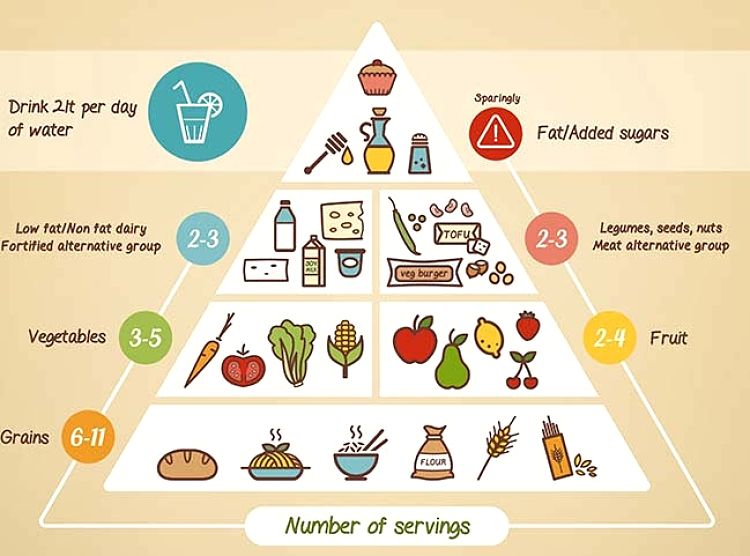
Amounts of Protein in commonly available foods
| Serving One Cup of Food | g of Protein | Oz of Protein |
| Pumpkin and squash seed kernels, roasted | 74.8 | 2.64 |
| Soy Flour | 47.0 | 1.66 |
| Tofu raw, firm, prepared wicalcium sulphate | 39.9 | 1.41 |
| Almonds, blanched | 29.6 | 1.04 |
| Oats | 26.4 | 0.93 |
| Lentils cooked | 17.9 | 0.63 |
| Rice brown - long grain, raw | 14.7 | 0.52 |
| Chicicpeas cooked | 14.5 | 0.51 |
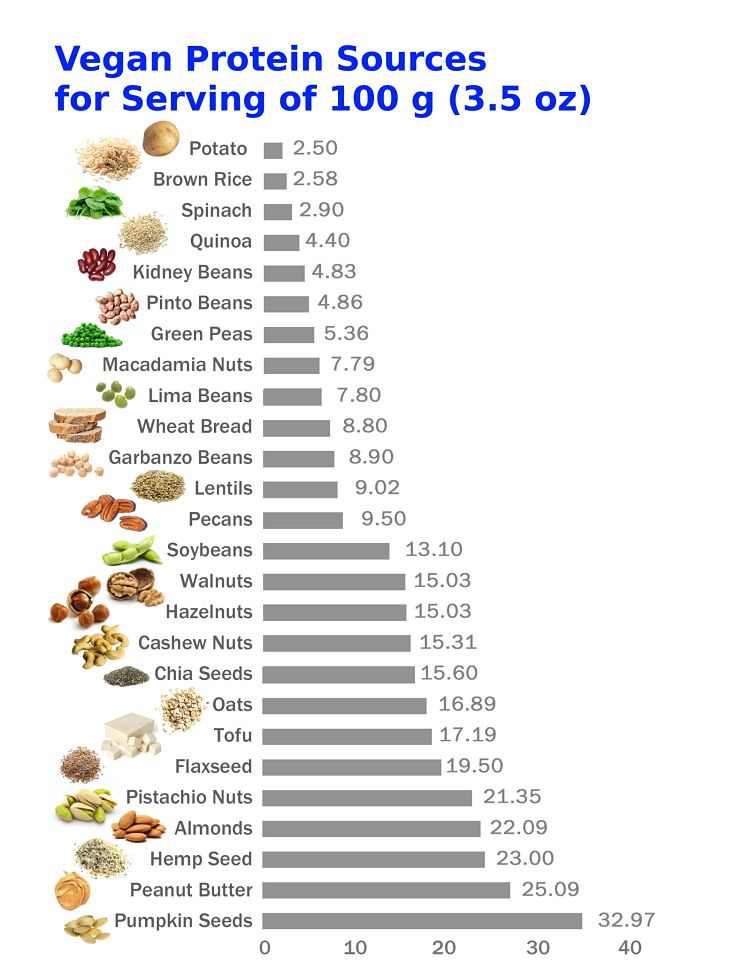
Sources of Vegetable Protein and Their Uses
Below are three of the best sources of protein for vegans:
Beans - There are a huge variety of beans: such as black, white, pinto, heirloom, etc. All varieties have high levels of protein. Two cups of kidney beans, for example, contains about 26 gm or protein, which is about the same amount as a Big Mac, which has 25 grams! Canned and dried beans contain the same amount if nutrients.
Buckwheat - Protein content: 6 grams per 1 cup, cooked. Buckwheat is a relative of rhubarb and is not related to wheat. Buckwheat is very healthy and is available in various forms for various used. Some studies have shown that it may improve circulation, lower blood cholesterol and control blood glucose levels.
Chia Seeds - These seeds are an easy way to add protein (4.7 grams per ounce, about 2 tablespoons) and fiber to a huge variety of recipes. Chia seeds can be sprinkled over salads, stirred into a breakfast yogurt or oatmeal, added and blended into smoothies. The seeds plump up and take on a gelatinous texture when soaked in a liquid, forming a rich and creamy pudding-like dessert.
Chickpeas - Also called garbanzo beans are legumes, like pulses. They can be tossed into salads, stir-fried for a crispy snack, or pureed into a hummus or smoothies. Chickpeas contain 7.3 grams of protein in just half a cup. They are also high in fiber and relatively low in calories.
Edamame - Get your servings of soy the natural way, raw from the soybean, still in their pods. Boiled edamame, which contains 8.4 grams of protein per half cup, can be served hot or cold and sprinkled with salt. Try it as an appetizer before dinner, a snack, and they can be added to salads, curries or pastas.
Green peas - Foods in the legume family are great sources of vegetarian protein. One cup of peas contains 7.9 grams or protein - about the same amount as a cup of milk. If you don't like peas as a side dish, try blending peas into a pesto with toasted pine nuts, fresh mint, olive oil, and Parmesan cheese.
Hemp Seeds - Adding hemp seeds to various dishes and salads can boost protein levels. Hemp seeds are found in cereals and trail mixes. You can buy hemp seeds (10 grams of protein in 3 tablespoons) and add them to smoothies, pestos, salads, curries, stir-fries or baked goods. Hemp milk can also be a dairy-free way to add protein to your diet with less calories than skim milk.
Leafy Greens - Green leaves and vegetables don't have nearly as much protein as legumes and nuts, but they do have significant amounts of protein to boost your intake. They are a great source of antioxidants, fiber and are rich in vitamins, minerals and other nutrients. Two cups of raw spinach contains 2.1 grams of protein, and one cup of chopped broccoli contains 8.1 grams.
Lentils - With 18 grams of protein per cup (240 ml) cooled, lentils are a fabulous source of protein. They can be used in fresh salads, hearty soups and spice-infused dahls. Lentils also contain slowly digested low GI carbs. One cup (240 ml) provides approximately 50% of your recommended daily fiber intake. Lentils are rich in folate, manganese and iron. They also are a great source of antioxidants and other health-promoting nutrients.
Non-Dairy Milk Alternatives - They can be great additions to any diet, provide you read the labels and avoid varieties with added sugar and fat and unhealthy flavors. Plain soy milk contains about 100 calories per cup, compared with skim milk's 80 calories. Soy milk has the most protein, at 4 to 8 grams per 8 ounces, but almond, hemp, and rice milk contain about 1 gram per cup and so are beneficial.
Nutritional Yeast - Nutritional yeast is a deactivated strain of Saccharomyces cerevisiae yeast. It is sold as a yellow powder or as flakes. It has a cheese-like taste. It has a wide range of uses and can be added to dishes such as mashed potatoes and scrambled tofu. Nutritional yeast can also be added to pasta dishes, added to baked goods and also to curries. Yeast is a complete source of plant protein providing 14 grams of protein and 7 grams of fiber per ounce (28 grams). Fortified nutritional yeast is also an excellent source of copper, manganese, zinc, magnesium and all the B vitamins, including B12.
Nuts - All nuts contain healthy fats and good levels of protein. However, because of their high fat content they are relatively high in calories. For example, almonds, cashews, and pistachios contain 160 calories and 5-6 grams of protein per ounce. Choose raw or dry roasted nuts to avoid added fat. Nut butters are also a good source of protein.
Oats and Oatmeal - Oats are a fabulous and delicious way to add protein to your diet. Half a cup of dry oats provides you with approximately 6 grams of protein and 4 grams of fiber. Oats also contains high amounts of magnesium, zinc, phosphorus and folate. You can use oats in many ways in a variety of recipes ranging from oatmeal, muesli, baked goods, smoothies and veggie burgers. They can also be ground into flour and used for baking.
Protein-Rich Fruits and Vegetables - All fruits and vegetables contain protein, but the amounts are generally small. Vegetables with the most protein include artichokes, potatoes, sweet potatoes, broccoli, spinach, asparagus and Brussels sprouts. They contain about 4–5 grams of protein per cup, cooked. Sweet corn is a common food that contains about as much protein as these high-protein vegetables. Fresh fruits generally have a lower protein content than vegetables. Fruit with the most protein include include mulberries, blackberries, nectarines, guava, cherimoyas and bananas, which have about 2–4 grams of protein per cup.
Quinoa - is a seed not a grain, but it considered a complete protein source with a rich array of amino acids. It also rich in fiber, magnesium, iron, phosphorus and is gluten-free. It should be thoroughly rinsed before cooking to remove the bitter coating substance that protects it from birds and insects. Itc an be used in a huge variety of ways by sprinkling into various dishes.
Seitan - Another vegetable protein source, popular with vegetarians, is seitan, which is made from wheat gluten, seasoned with salt and savory flavors. It is loaded with protein, with 36 grams per half cup, more than both tofu or tempeh. It tastes like chicken, and can be used in any recipe that calls for poultry.
Sesame, Sunflower and Poppy Seeds - Per volume, sunflower seed kernels contain the most protein at 7.3 grams per quarter cup. Sesame seeds and poppy seeds contain 5.4 grams of protein.) Be creative as these seed have a huge range of uses and add flavor and nutrients to a wide variety fo dishes.
Soy Milk - This milk alternative, made from soybeans and fortified with vitamins and minerals is a great substitute for dairy milk. Soy milk contain 7 grams of protein per cup (240 ml). It is an excellent source of calcium, vitamin D and vitamin B12 (added in fortified varieties).
Spelt and Teff - Spelt and teff are classified as ancient grains. Other ancient grains include einkorn, barley, sorghum and far. Spelt is a type of wheat and contains gluten, whereas teff originates from an annual grass and is gluten-free. Spelt and teff provide 10–11 grams of protein per cup (240 ml), cooked. This makes making them higher in protein than other ancient grains. Both are excellent sources of various nutrients, including complex carbohydrates, fiber, iron, magnesium, phosphorus and manganese. They are also a great source of B vitamins, zinc and selenium. Spelt and teff are fabulous alternatives to common grains, such as wheat and rice, and can be used in many recipes ranging from baked goods to polenta and risotto.
Spirulina - This blue-green algae is a super food. Two tablespoons (30 ml) provides 8 grams of complete protein, in addition to covering 42% of your daily copper and 22% of your daily requirements of iron and thiamin. Spirulina also contains high amounts of magnesium, riboflavin, manganese, potassium and small amounts of other nutrients, including essential fatty acids. Phycocyanin, a natural pigment found in spirulina, is reported to be a powerful antioxidant, anti-inflammatory and anti-cancer properties.
Tempeh - is made by fermenting soybeans with a thizopus. It can be made with soy, combined with grains, seeds, and legumes. It has a nutty taste and a firm, tender, and chewy texture and has high levels of protein. Like tofu, it absorbs the flavors of spices and marinades and has a wide range of uses.
Tofu - Tofu is made by treating soybean milk with coagulants. It is also known as soybean curd and resembles cheese in texture and taste. It has a high protein content and absorbs flavors very well. It is less bland than tofu. There are soft, firm, and extra firm varieties. The soft tofu is smoother and lower in fat and is best used in sauces, salad dressings, and desserts. The firm and extra firm tofu are best used in grilling, baking, and stir-frying.
Wild Rice - Wild rice contains about 1.5 times as much protein as most other varieties of long-grain rice, including brown rice and basmati. One cup (240 ml), cooked, provides 7 grams of protein, in addition to a good amount of fiber, manganese, magnesium, copper, phosphorus and B vitamins. Unlike white rice, wild rice is not stripped of its bran. This is a benefit as the bran contains fiber and a great array of vitamins and minerals.
List of Vegan Foods Rich in Protein
|
Food
|
Amount
|
Protein (gm)
|
|---|---|---|
|
Tempeh
|
1 cup
|
41
|
|
Almonds
|
1 cup
|
32
|
|
Seitan
|
3 oz
|
31
|
|
Soybeans, cooked
|
1 cup
|
29
|
|
Sunflower seeds
|
1 cup
|
24
|
|
Cashews
|
1 cup
|
20
|
|
Lentils, cooked
|
1 cup
|
18
|
|
Black beans, cooked
|
1 cup
|
15
|
|
Kidney beans, cooked
|
1 cup
|
13
|
|
Chickpeas, cooked
|
1 cup
|
12
|
|
Pinto beans, cooked
|
1 cup
|
12
|
|
Black-eyed peas, cooked
|
1 cup
|
11
|
|
Tofu, firm
|
4 oz
|
11
|
|
Lima beans, cooked
|
1 cup
|
10
|
|
Peas, cooked
|
1 cup
|
9
|
|
Quinoa, cooked
|
1 cup
|
9
|
|
Tofu, regular
|
4 oz
|
9
|
|
Peanut butter
|
2 tbsp
|
8
|
|
Soy milk
|
1 cup
|
7
|
|
Bulgar, cooked
|
1 cup
|
6
|
|
Soy yogurt, plain
|
6 oz
|
6
|
|
Almond butter
|
2 tbsp
|
5
|
|
Brown rice, cooked
|
1 cup
|
5
|
|
Spinach, cooked
|
1 cup
|
5
|
|
Whole wheat bread
|
Two slices
|
5
|
|
Broccoli, cooked
|
1 cup
|
4
|
Below are some of the most common nutrients that may be lacking in a vegetarian diet apart from essential amino acids.
Omega-3 fatty acids
To a some extent, your body can synthesise essential fatty acids from alpha-linolenic acid (ALA), which is another essential fatty acid. ALA occurs in canola oil, flaxseed oil, flaxseeds, walnuts, and tofu, ad particularly microalgae oil.
Solution:
· Use micro algae oil in vegan diets as a replacement for fatty fish consumption
· Use flaxseeds or flaxseed oil (ground or crushed) in your diet as a source of ALA. Don't heat the oil when using it and its destroyed by heat.
· Reduce on your intake of omega-6 fatty acids by replacing plant oils with olive oil or rapeseed oil.
Vitamin B12
Vitamin B12 is tied to the protein in animal foods and it is very hard to get it from vegetables without using supplements. To avoid any deficiency, vegans should frequently eat vitamin B-12–fortified foods, for example soy and rice beverages, breakfast cereals , yeast fortified with B-12, or take vitamin B-12 supplements daily. Fermented soy products, seaweed and leafy vegetables, are unreliable sources of active vitamin B-12 (the vegetable variety may be inactive). No unfortified plant food has enough active vitamin B-12 and supplements are the safety way to go.
Solution:
- Consume vitamin B12 fortified food 2-3 times a day,
- As a precaution take a B12 supplement especially for people with increased needs such as pregnant, and lactating women and the elderly
- Cut down on excessive amounts of folate supplements, as this can hide a B12 deficiency
- Have your doctor check your B12 level to ensure you are managing it.
Calcium
The best sources of dietary calcium is dairy foods, which are missing from vegan diets. The nondairy foods that are good sources of calcium are calcium-fortified tofu, fortified soy milk, some roots and legumes. Vegan need to ensure they get enough calcium in their diet to avoid bone disease and other issues associated with calcium deficiency. Bone health depends on more than just protein and calcium intakes. Research has shown that bone health is also influenced by nutrients such as vitamin D, vitamin K, potassium, and magnesium and by foods such as soy and fruit and vegetables. Vegan diets generally provide most of these substances. The link between vitamin D and calcium absorption is also important. Vitamin D enhances absorption, while phytic acid and oxalic acid block the absorption. Foods rich in oxalic acid and phytic acid are spinach, unleavened bread, nuts, seeds, rhubarb, sweet potatoes and raw beans.
Solution:
- Vegans should consume calcium-fortified soy milk or juices on a daily basis, calcium-rich foods throughout the day, and consider taking a daily supplement.
- Calcium intake should to be distributed throughout the day for optimal absorption.
Iron
Iron is essential for general health and carrying oxygen in the blood. Meat is rich in iron because its associated with haemoglobin in blood. Vegans need to be careful they get enough iron from vegetable sources. Iron deficiency causes fatigue and diminished immune function. There are two forms of dietary iron: nonheme and heme iron. Nonheme iron is found in plants whereas Heme iron, associated with haemoglobin, is found in animal foods.
Solution:
- Consuming vitamin C (citrus juice and fruits, kiwi fruit, green and red peppers) at the same time that you consume foods with nonheme iron will increase iron absorption.
- Calcium, phytates and tannins interfere with the absorption of iron. Tannins are found in coffee and tea. Phytates are found in legumes and whole grains. So these foods need to be avoided with eating calcium rich foods or taking supplements.
Vitamin D
Research studies have shown that vegans had the low intake level of vitamin D (0.88 gm per day), a value only 25% of the mean intake of omnivores. For a vegan, vitamin D intake depends on the intake of vitamin D-fortified foods and sun exposure. People living at high latitudes, dark-skinned people or those who spend long hours indoors should be careful to take adequate vitamin D in their food or in supplements. Various vegetables are rich sources of vitamin D.
Solution:
- Vegans must regularly consume vitamin D–fortified foods such as soy milk, rice milk, orange juice, breakfast cereals, and margarines or supplements.
Zinc
Vegans should be aware of there need to maintain adequate levels of zinc intake in their diets and through supplements.
Summary of Key Nutrients likely to be a Problem for Vegans
|
Nutrient
|
Function
|
Non-Vegan Sources
|
Vegan Sources
|
|---|---|---|---|
|
Vitamin B12
|
Helps make DNA; Producing and maintaining new cells; helps maintain the nervous system
|
Mollusks, clams
|
Fortified foods
|
|
|
|
Beef liver
|
Breakfast cereals
|
|
|
|
Trout
|
Vegetable stock
|
|
|
|
Salmon
|
Vegetable and sunflower margarines
|
|
|
|
Beef
|
Veggie burgers
|
|
|
|
Yogurt
|
Textured vegetable protein
|
|
|
|
Haddock
|
Yeast extracts
|
|
|
|
Tuna
|
Soy milk
|
|
|
|
Milk
|
|
|
|
|
Eggs
|
|
|
Calcium
|
Contraction and expansion of blood vessels and muscles; Strong bones;send message to nervous system; secrete hormones and enzyme
|
Milk
|
Fortified soy milk
|
|
|
|
Cheese
|
Fortified juice
|
|
|
|
Cottage cheese
|
Tofu-made w/calcium sulfate
|
|
|
|
Salmon w/bones
|
Soybeans
|
|
|
|
Sardines w/bones
|
Soy nuts
|
|
|
|
Yogurt
|
Bok choy
|
|
|
|
|
Kale
|
|
|
|
|
Mustard greens
|
|
|
|
|
Blackstrap molasses
|
|
Iron
|
Regulation of cell growth and differentiation; Transport oxygen; integral part of many proteins and enzymes
|
Heme iron:
|
Non-heme iron:
|
|
|
|
Chicken liver
|
Chickpeas
|
|
|
|
Oysters
|
Lentils
|
|
|
|
Beef
|
Beans
|
|
|
|
Clams
|
Fortified cereal
|
|
|
|
Turkey
|
Fortified oatmeal
|
|
|
|
Chicken
|
Tofu
|
|
|
|
Tuna
|
Wheat
|
|
Omega-3 Fatty Acids
|
Reduce triglyceride levels; protect against atherosclerosis; act as an antiinflammatory; possibly help with depression and other personality disorders; and possibly thin the blood
|
Fatty fish:
|
|
|
|
|
Anchovies
|
Microalgae oil
|
|
|
|
Bluefish
|
Source EPA:
|
|
|
|
Carp
|
Flaxseed oil
|
|
|
|
Catfish
|
Flaxseeds
|
|
|
|
Halibut
|
Rapeseed
|
|
|
|
Herring
|
|
|
|
|
Lake trout
|
|
|
|
|
Mackerel
|
|
|
|
|
Pompano
|
|
|
|
|
Salmon
|
|
|
|
|
Striped sea bass
|
|
|
|
|
Whitefish
|
|
|
|
|
White tuna (Albacore)
|
|
